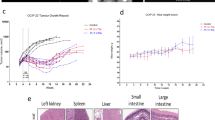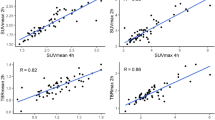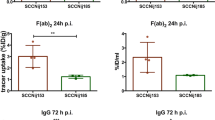Abstract
Non-invasive predictive assays which can confirm the presence or absence of hypoxic cells in human tumours show promise for understanding the natural history of tumour oxygenation, and improving the selection of patient subsets for novel radiotherapeutic strategies. Sensitiser adducts have been proposed as markers for hypoxic cells. Misonidazole analogues radiolabelled with iodine-123 have been developed for the detection of tumour hypoxia using conventional nuclear medicine techniques. In this pilot study, we have investigated one such potential marker, 123I-iodoazomycin arabinoside (123I-IAZA). Patients with advanced malignancies have undergone planar and single-photon emission computed tomographic (SPECT) imaging after intravenous administration of 123I-IAZA. We have observed radiotracer avidity in three out of ten tumours studied to date. Normal tissue activity of variable extent was also seen in the thyroid and salivary glands, upper aerodigestive tract, liver, intestine, and urinary bladder. Quantitative analysis of those images showing radiotracer avidity revealed tumour/normal tissue (T/N) ratios of 2.3 (primary small cell lung carcinoma), 1.9 (primary malignant fibrous histiocytoma) and 3.2 (brain metastasis from small cell lung carcinoma) at 18-24 h post injection. These preliminary data suggest that the use of gamma-emitter labelled 2-nitroimidazoles as diagnostic radiopharmaceuticals is feasible and safe, and that metabolic binding of 123I-IAZA is observed in some, but not all tumours. The inference that tumour 123I-IAZA avidity could be a non-invasive measure of tumour hypoxia deserves independent confirmation with needle oximetry.
This is a preview of subscription content, access via your institution
Access options
Subscribe to this journal
Receive 24 print issues and online access
$259.00 per year
only $10.79 per issue
Buy this article
- Purchase on Springer Link
- Instant access to full article PDF
Prices may be subject to local taxes which are calculated during checkout
Similar content being viewed by others
Author information
Authors and Affiliations
Rights and permissions
About this article
Cite this article
Parliament, M., Chapman, J., Urtasun, R. et al. Non-invasive assessment of human tumour hypoxia with 123I-iodoazomycin arabinoside: preliminary report of a clinical study. Br J Cancer 65, 90–95 (1992). https://doi.org/10.1038/bjc.1992.17
Issue Date:
DOI: https://doi.org/10.1038/bjc.1992.17
This article is cited by
-
Radioiodinated doxorubicin as a new tumor imaging model: preparation, biological evaluation, docking and molecular dynamics
Journal of Radioanalytical and Nuclear Chemistry (2018)
-
Molecular imaging of hypoxia with radiolabelled agents
European Journal of Nuclear Medicine and Molecular Imaging (2009)



